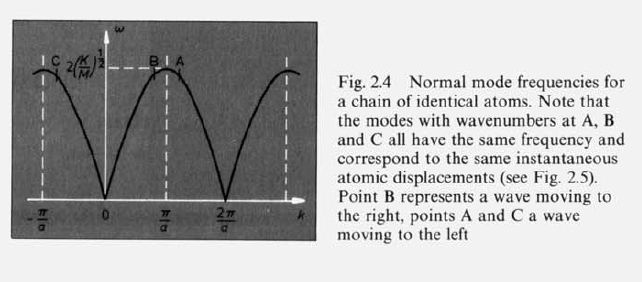Solution to Set 5: Difference between revisions
(Adding to Problem 1 Solution) |
|||
| Line 1: | Line 1: | ||
' | <font color="blue"> I have no idea what I'm doing - [[User:KimberlyWynne|KimberlyWynne]] 03:11, 2 March 2009 (EST)</font> | ||
'''Diatomic harmonic chain''' | '''Diatomic harmonic chain''' | ||
==Problem 1== | ==Problem 1== | ||
Given: | '''Given:''' | ||
* a chain of atoms | * a chain of atoms | ||
* with alternating masses <math>m_1\;</math> and <math>m_2\;</math> | * with alternating masses <math>m_1\;</math> and <math>m_2\;</math> | ||
* connected with elastic springs with constant <math>K\;</math> | * connected with elastic springs with constant <math>K\;</math> | ||
* moving only in the x-direction | * moving only in the x-direction | ||
[[Image:chainatoms.jpg]] | [[Image:chainatoms.jpg]] | ||
Derive the dispersion relation <math>\omega^{\alpha} (k)\;</math> for this chain | '''Derive the dispersion relation <math>\omega^{\alpha} (k)\;</math> for this chain''' | ||
* Index <math>\alpha = 1\;</math> for acoustic branch | * Index <math>\alpha = 1\;</math> for acoustic branch | ||
* Index <math>\alpha = 2\;</math> for optical branch | * Index<math>\alpha = 2\;</math> for optical branch | ||
Potential Energy <math>U = 1, 2, 3, ... N \;</math> | |||
<math>U \cong \frac{1}{2} k \sum_{n} (U_n - U_{n-1}) \;</math> | |||
Eigenvectors | |||
[[Image:Dispersionrelation.jpg]] | [[Image:Dispersionrelation.jpg]] | ||
Revision as of 04:11, 2 March 2009
I have no idea what I'm doing - KimberlyWynne 03:11, 2 March 2009 (EST)
Diatomic harmonic chain
Problem 1
Given:
- a chain of atoms
- with alternating masses and
- connected with elastic springs with constant
- moving only in the x-direction
Derive the dispersion relation for this chain
- Index for acoustic branch
- Index for optical branch
Potential Energy
Eigenvectors
Problem 2
Determine the speed of sound for this chain. What is the lowest frequency of long-wavelength sound corresponding to the optical branch?
From my lecture notes:
where = speed of sound
Problem 3
Sketch the motion of the atoms corresponding to the edge of the Brillouin zone, both for the optical and the acoustic branch.
Problem 4
Determine the Debye temperature for this system, and determine the form of the specific heat in the limits of high and low temperatures.
Problem 5
Consider low temperatures () and determine the wavelength of the most abundant phonons (Hint: note the analogy with Wien's Law!)














